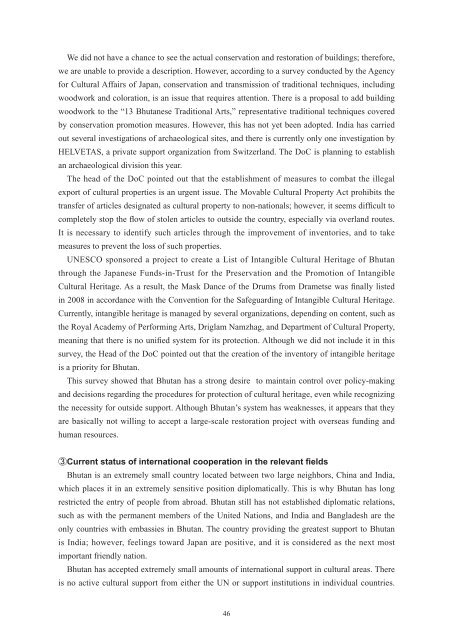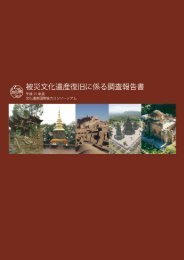English - JCIC-Heritage
English - JCIC-Heritage
English - JCIC-Heritage
Create successful ePaper yourself
Turn your PDF publications into a flip-book with our unique Google optimized e-Paper software.
We did not have a chance to see the actual conservation and restoration of buildings; therefore,<br />
we are unable to provide a description. However, according to a survey conducted by the Agency<br />
for Cultural Affairs of Japan, conservation and transmission of traditional techniques, including<br />
woodwork and coloration, is an issue that requires attention. There is a proposal to add building<br />
woodwork to the “13 Bhutanese Traditional Arts,” representative traditional techniques covered<br />
by conservation promotion measures. However, this has not yet been adopted. India has carried<br />
out several investigations of archaeological sites, and there is currently only one investigation by<br />
HELVETAS, a private support organization from Switzerland. The DoC is planning to establish<br />
an archaeological division this year.<br />
The head of the DoC pointed out that the establishment of measures to combat the illegal<br />
export of cultural properties is an urgent issue. The Movable Cultural Property Act prohibits the<br />
transfer of articles designated as cultural property to non-nationals; however, it seems difficult to<br />
completely stop the flow of stolen articles to outside the country, especially via overland routes.<br />
It is necessary to identify such articles through the improvement of inventories, and to take<br />
measures to prevent the loss of such properties.<br />
UNESCO sponsored a project to create a List of Intangible Cultural <strong>Heritage</strong> of Bhutan<br />
through the Japanese Funds-in-Trust for the Preservation and the Promotion of Intangible<br />
Cultural <strong>Heritage</strong>. As a result, the Mask Dance of the Drums from Drametse was finally listed<br />
in 2008 in accordance with the Convention for the Safeguarding of Intangible Cultural <strong>Heritage</strong>.<br />
Currently, intangible heritage is managed by several organizations, depending on content, such as<br />
the Royal Academy of Performing Arts, Driglam Namzhag, and Department of Cultural Property,<br />
meaning that there is no unified system for its protection. Although we did not include it in this<br />
survey, the Head of the DoC pointed out that the creation of the inventory of intangible heritage<br />
is a priority for Bhutan.<br />
This survey showed that Bhutan has a strong desire to maintain control over policy-making<br />
and decisions regarding the procedures for protection of cultural heritage, even while recognizing<br />
the necessity for outside support. Although Bhutan’s system has weaknesses, it appears that they<br />
are basically not willing to accept a large-scale restoration project with overseas funding and<br />
human resources.<br />
3Current status of international cooperation in the relevant fields<br />
Bhutan is an extremely small country located between two large neighbors, China and India,<br />
which places it in an extremely sensitive position diplomatically. This is why Bhutan has long<br />
restricted the entry of people from abroad. Bhutan still has not established diplomatic relations,<br />
such as with the permanent members of the United Nations, and India and Bangladesh are the<br />
only countries with embassies in Bhutan. The country providing the greatest support to Bhutan<br />
is India; however, feelings toward Japan are positive, and it is considered as the next most<br />
important friendly nation.<br />
Bhutan has accepted extremely small amounts of international support in cultural areas. There<br />
is no active cultural support from either the UN or support institutions in individual countries.<br />
46




